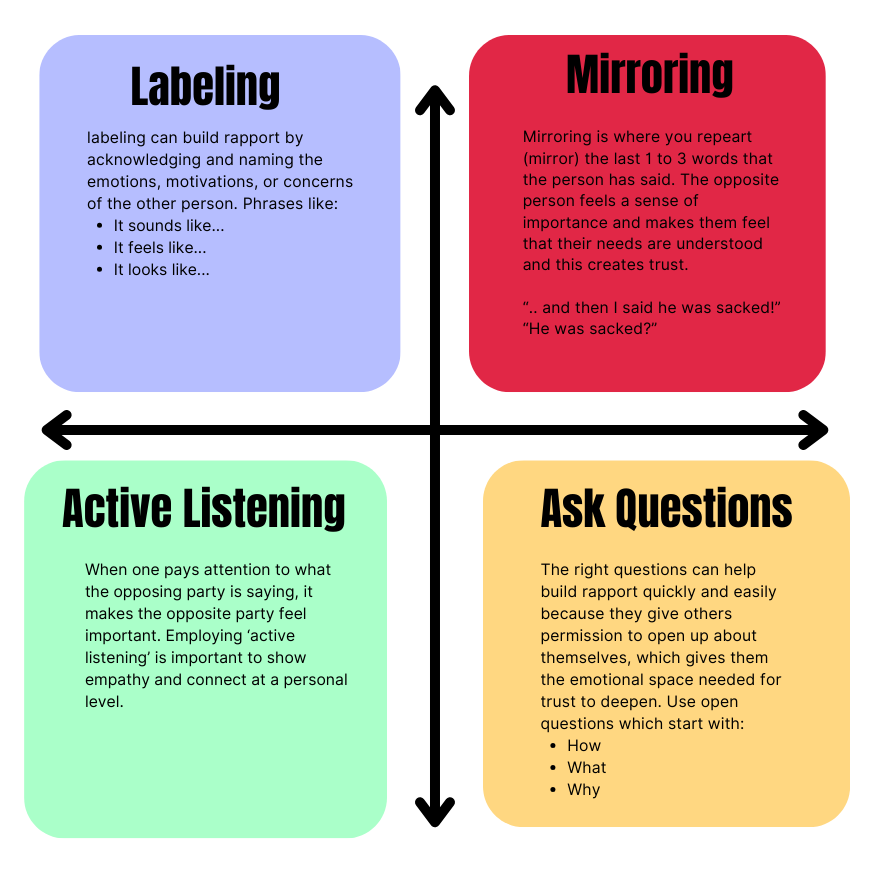How to build rapport as a C-level executive can be difficult; however, we have broken down each element you will need to build an unbreakable relationship and have people WANT to be around you.
- Actively listen
- Ask Questions
- Labeling
- Mirroring
- The Rapport Formula
If you are ready to begin charisma coaching and start to improve your relationship-building skills, then schedule your discovery call below:

Active Listening
C-level executives run busy organizations; you have a million things on your mind, from upcoming board meetings and industry changes to driving the latest new strategy of your organization. The challenge is when you are with someone; you can appear ‘distant’ or not in the moment because you have all these challenges running through your mind.
Listening cannot be done passively; in fact, it is one of the most active things you can do. It’s imperative that you are listening to the other person you are speaking to. It can be hard to focus on the person in front of you, but it is critical when it comes to building rapport; otherwise, you will come across as disingenuous.
To truly be actively listening to someone, you are not just listening to the words they are saying; you are looking out for the emotions, fears, motives, inspirations behind the work. Let’s look at some examples:
“Work has been getting me stressed.”
This one is obvious because they are physically telling you their emotions, in this case, they are stressed, and you can follow up by asking about why they are feeling this way. Sometimes it’s not as obvious:
“Work has been busy; I’m okay, How have you been?”
Listen to the tone, look at their body language, and gauge how they are feeling behind the words they are saying. Do they seem excited by being busy at work? Does this bring new and exciting challenges? or Do they seem anxious and worried about the workload? Ask great follow-up questions based on these emotions.
Here are some examples of emotions to listen for:
- Excitement
- Positivity
- Anxious
- Happiness
- Disgust
- Boredom
- Sadness
- Pride
- Joy
- Anger
- Fear
Ask Questions
Let’s get real, you probably ask your team questions every day, questions like:
- How was the traffic?
- Did you complete the task I gave you?
- What’s for lunch?
Do you believe that a general work chat is going to help you become an inspirational leader or build better rapport? Sadly, it will get you nowhere. To build a deep and meaningful connection as a C-level executive, you need to ask effective questions that make people think and look into themselves.
What is a ‘Great’ Question?
While there is no perfect question, great questions do have a process, questions that make people think are what are called open questions. These are questions which start with:
- How
- What
- Why
These are effective because they make the other person give an answer which is more than yes or no; it’s inviting them to give more information.
How to Build Rapport With Questions
To build rapport as a C-level executive through questions is simple; you want to ask questions that get the other person to open up about themselves. The aim of this is to find some common ground and make an emotional connection with the other person. It’s important to know that people will leave feeling like they have made a deep connection, but all they have done is talk about themselves.
As a C-Level executive, you have lots of ideas, opinions, and views on a lot of subjects; you need to hold back and adopt the role of a talk show host. Let’s look at Graham Norton; the audience isn’t interested in what the host is saying; they are interested in whichever celebrity is on the sofa that day. You have to be the talk show host and make the other person the guest and in the spotlight.
See below some examples of great open questions:
- What do you do outside of work?
- What has been the highlight of your career/journey so far?
- How do you envision your career progressing in the next few years?
- What challenges do you find most interesting to tackle in your role?
- What has been your most memorable travel experience?
- Why did you get started in this industry?
- How do you find working in X
You can see that asking questions that get people to think and look into themselves can have a huge impact and help build charisma.
Labeling
A technique I have been teaching with charisma coaching clients has been labeling; it is extremely effective when you are looking to build rapport as a C-level executive. Labeling is the process of identifying the feelings, thoughts, motives, or desires of the other person and saying them out loud. Labels start with:
- It seems like…
- It looks like…
- it feels like…
This can help to build rapport as the other person feels reassured hearing their thoughts out loud but also gives them a sense that you understand the situation from their perspective; let’s look at an example:
Board Member: “We are seeing a decline in sales over the last 12 months, and with us spending more money on hiring new staff, it looks like we will not turn a profit this year!”
You: “It seems like you are frustrated at the lack of sales.”
Board Member: “That’s right; I just want us to turn this around.”
You: “It also feels like you are not 100% sure why we hired the new staff and how they can impact our success.”
Board member: “Well yes, that’s true.”
You: “Well let me just explain…”
From this example, you can see how labeling can help emphasize people in difficult situations; by labeling the board members’ fears and concerns made them feel understood which in turn increased their fondness towards you. When we label like this, people will see us as more competent because we confirm their thoughts clearly which also helps us build trust.
How a C-Level Executive Can Use Labeling
A C-level executive can use labeling in the following situations:
- Defuse a difficult staff member
- During a negotiation
- Responding to board member queries
- Dealing with criticism
- While networking
- Motivating team members
- Building trust and rapport
- Managing a crisis
If you are asking yourself “How to Build Rapport as a C-Level Executive?” then labeling is a great technique.
Mirroring
They say copying is the highest form of flattery, so let’s see if we can use it to build better rapport as a C-level executive. When I was negotiating an offer for one of our charisma coaching programs, I remember the client feeling a little anxious; he said to me “Charisma no one knows what it is, how do I know if after your program I will have it?” I responded by the mirroring technique as I wanted to build rapport to comfort the potential client I said “How would you know if you have it?” I responded by saying the last 1-3 words that they said back at them. He responded by saying “Yeah like will I be able to become more memorable and have an executive presence?”
You see humans find comfort in things similar to us, we are attracted to and like them more. This is why mirroring is an effective tool for a C-level executive to build rapport. In the example with the client, he felt like his concerns were being heard and felt a greater affection toward me, and in the end, we got the deal done.
Let’s look at some more examples:
Board member: “ I have been investing in organizations like this for 35 years!”
You: “You have been investing for 35 years?”
Board member: “Oh yes and it changed a whole lot in that time, I can even remember my first investment”
From this example, you can see how the rapport-building process can build as it gives you options to ask questions and label the board members’ thoughts, feelings, and motives which will increase your likeability.
The Rapport Building Formula

One of the last principles that a C-level executive needs to adopt to become effective in building rapport is understanding “The Rapport Building Formula”. The formula is simple:
Rapport = Proximity + Frequency + Duration + Intensity.
Let’s break down each of these and how they can impact you as a C-level executive
Proximity
This is how close physically you are to the person you are trying to build rapport with. You do not need to be squished up next to them, but you have to be at least visible to them. Some of the CEOs and executives I work with have their offices on the 21st floor, and the staff are on the 2nd floor, and they wonder why they have no relationship with their leaders. You have to be visible to the people who are looking to build rapport with.
Frequency
How regularly are you meeting this person? If you just see them once a year, then your rapport is not going to be very strong. Let’s go back to our example of the CEO on the 21st floor if you come down to meet with the staff in your office just at the annual corporate meeting and throughout the year you are out of sight, you are not going to be able to build a good relationship with your staff or managers.
Duration
When it comes to building rapport with someone, you have to spend time with them. This can be in regular performance reviews, coffee chats, rounds on the golf course, or wherever you need to be with them for some time to build up this relationship. Imagine you walk into a jewelry store, and the assistant immediately runs over to you and says “You know we have a huge sale today” How inclined are you to buy something from them? Not at all because you don’t even know this person. Instead, if the store assistant gave you a gentle smile and wave, allowed you to walk around for 10 mins then approached you will find that they naturally built up a bit of rapport because they have been in your vicinity for a while.
Intensity
This describes the richness of the conversations you are having. You want to be having deep meaningful conversations with the other person finding common ground and connecting on an emotional level. While chatting about the weather or traffic isn’t inherently bad, you do not have the level of intensity you need to develop a strong bond with the person. Find out their interests, hobbies, passions, desires, motivation
Need to know
With The Rapport Formula is important to know that you can dial up and dial down each of the elements. For example, if you see someone once a year because they live abroad, you can still build rapport with them because perhaps you spend a long time with them and have a very intense conversation. Similarly, if you see a colleague every day in the canteen for just a few minutes but have an interesting conversation more regularly, you can build rapport.



